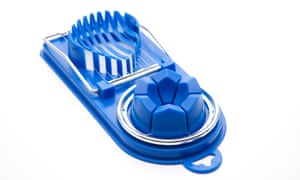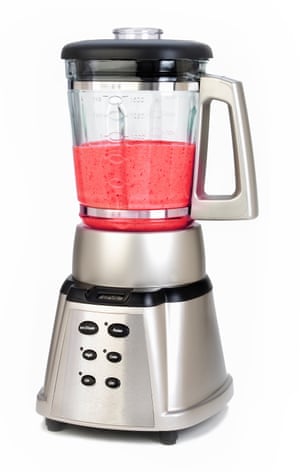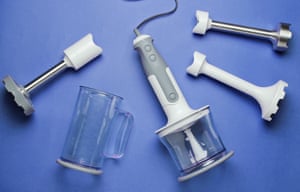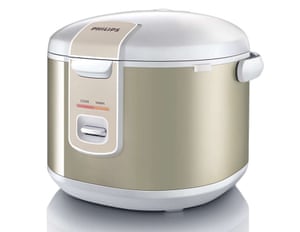‘If it has an ingredient in the name, avoid it’: Adam Liaw on the kitchen appliances you’ll actually use | Food
Utensils, gadgets, small appliances, large appliances – there are a lot of things competing for precious space in your kitchen. As kitchen design trends toward smaller, more efficient spaces, it’s more important than ever to separate the must-haves from the kitchen drawer detritus of the future.
Here’s a simple guide to what you need in the kitchen, and what you don’t.
Gadgets
If something can be described as a gadget in the kitchen it’s probably not something you need. A good rule of thumb is that if it has an ingredient in the name, avoid it. From egg slicers to bean splitters, single-ingredient gadgets are the impulse buys of the kitchen.

For some reason garlic seems to attract a lot of equipment. Flexible tubes for peeling, mechanical presses for crushing, and even pieces of metal that supposedly get the smell off your hands – all answers to questions few were asking in the first place. All you need to deal with garlic is a knife. Bash it with the flat to peel it and squash it, or chop it with the blade.
Food processors
Food processors can be useful, but in truth I moved mine from the “sometimes” cupboard to the “almost never” storage years ago.
The promise of efficiently chopping or shredding vegetables in seconds is a false economy for anyone halfway proficient with a knife or box grater. That said, if you’re regularly making short pastries, breadcrumbs, fish cakes or commercial quantities of coleslaw, it might not be a bad thing to have.

High-speed blender
High-end, high-speed blenders might be seen as the ultimate in small appliance gimmickry, but here’s the thing – they’re great. I grew up in a kitchen where blenders were used regularly to make spice pastes, sauces and soups, and half your time was spent trying to coax them into working properly. The modern crop of high-speed devices are a game-changer. Even if you have no interest in smoothies, these can blitz super-fine flours, nut milks, pastes, sauces and soups without needing to strain them. I use mine a lot. Adding a heating element in it is a bit of a luxury, though.
Stick blender
Stick blenders are useful in that there is no transferring of hot liquids from pot to blender, but at the same time they don’t do as complete a job of blending as the vortex of a jug blender can. The thing that makes stick blenders really useful, however, is the small capacity food processor attachments they can power.
As with all appliance choices, what you need will depend entirely on what you cook. If you’re making lots of apple crumble, fish cakes and creamy soups perhaps a full-sized food processor and blender will be best for you, but otherwise you may well be able to make do with a stick blender for the occasional whizz and whirr.

Stand mixers
Stand mixers are brilliant. I can’t imagine how you’d make a pavlova or Italian meringue without one. Easier to use and clean than hand-held mixers, if you have the money and space in your kitchen they’re a worthwhile acquisition. I use mine for a lot of things like making pastries and doughs, dumpling fillings (yes, they make great dumpling fillings) and these days they come with once-in-a-while attachments you can use on the rare occasion you might find yourself making pasta, mincing your own hamburgers or filling sausages.
Microwaves
It’s certainly not new technology but I feel like microwaves have fallen out of favour in recent years. There’s little innovation to trigger marketing, which probably explains why we haven’t seen a microwave advertisement for about 15 years, but regardless I am a big fan of microwaving.
They’re great for cooking vegetables as they use their natural moisture content so nutrients and flavours aren’t diluted, and if there’s a better way of cooking potatoes I’m yet to find it. Pre-cooking for 10 minutes in the microwave before transferring to the oven will save you half an hour of roasting time on your spuds.
Rice cookers

This is the exception to the “ingredient name” rule: if you eat rice with any kind of regularity, a rice cooker is a necessary appliance. Just ask Uncle Roger. I recommend ones that are sealed, as they hold cooked rice outside the danger zone for bacterial growth, meaning you have warm rice ready and on hand when you need it.
Air-fryers
If you haven’t seen one before, an air-fryer is a small convection oven that circulates very dry, hot air around food with a promise of crisp results, similar to frying without the need for a lot of oil.
Fear of dietary oils may not be the most up-to-date nutrition advice, but much of the appeal of air-fryers is not having to deal with the mess and hassle of heating and handling oil for deep-frying. For the most part, air-fryers deliver on their promise, but they have drawbacks.
They’re big on the outside and small on the inside, meaning they take up a lot of bench space while only having limited capacity. Even the largest models would struggle to air-fry enough chips for a family of four. They’re also more suited to pre-cooked frozen foods like oven fries, fish fingers and nuggets, so if you eat enough of these to warrant a full-time appliance on your bench, an air-fryer might be for you.
Induction cooktops
Are induction cooktops worth the expense? I think they are. For speed, there is nothing faster. Boiling water for pasta takes a fraction of the time it would on gas or electric, and induction does offer more precision control than other cooktops.
On the downside, your cooking has to be relatively static, as tossing pans or woks will result in losing heat, and you do need to have pots and pans that are compatible with induction, which can be expensive (on top of the already significant cost of the cooktop). The thing that seals the deal for me is efficiency. Induction is very energy efficient, using only around a third of the electricity of an electric element.
Steam ovens
They’re not cheap, but I think steam ovens are brilliant. Most manufacturers miss the point by trying to convince you to use them to make restaurant-style meals, without realising that most of us have absolutely no intention of making restaurant-style meals at home.
I think steam ovens best for simple things. I use mine for frozen dumplings, steaming whole fish – without having to worry about whether it will fit in a bamboo steamer – or for making tender, flavourful chicken breast (62C for 45 minutes). Rather than making the gourmet possible, I think they make the simple simpler, and that’s a great thing for an appliance to do.
 VIGA Faucet Manufacturer
VIGA Faucet Manufacturer 